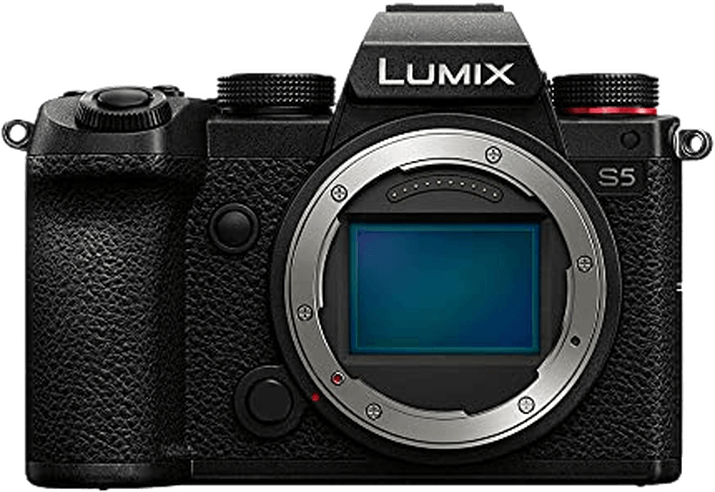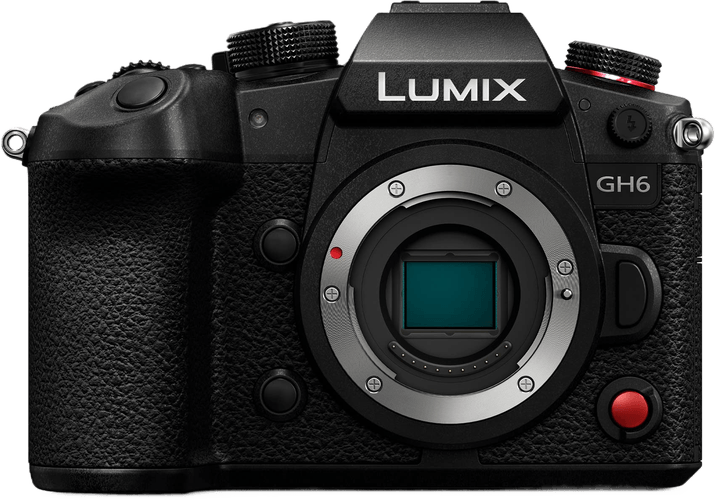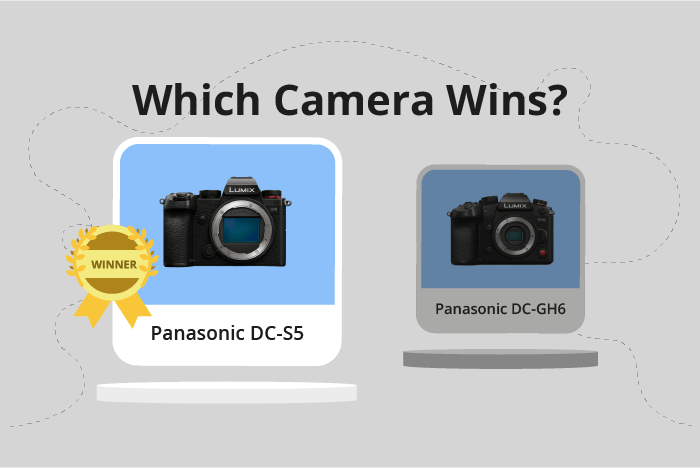Panasonic Lumix DC-S5 vs Lumix DC-GH6 Comparison
Panasonic Lumix DC-S5

Panasonic Lumix DC-GH6

The Panasonic Lumix DC-S5 outperforms the Panasonic Lumix DC-GH6 with a score of 79/100 compared to 73/100. Both cameras are mirrorless and were released in 2021 and 2022, respectively. They share similarities in camera type, and their launch prices are $1999 for the S5 and $2199 for the GH6.
The S5 has a smaller size (133 x 97 x 82mm) and is lighter (714g) than the GH6 (138 x 100 x 100mm and 823g). This makes the S5 more portable and convenient for photographers on the go. However, the GH6 has a higher launch price, which may imply some additional features or improvements over the S5.
In terms of performance, the S5 is the clear winner with a higher score. The GH6 may still have some advantages, but they do not outweigh the benefits of the S5. When considering the specifications, the S5 offers better value for money and portability, making it the preferred choice for most photographers.
Panasonic Lumix DC-S5 vs Lumix DC-GH6 Overview and Optics
The Panasonic Lumix DC-S5 outperforms the Panasonic Lumix DC-GH6 in optics, scoring 78/100 points compared to the GH6’s 69/100 points. Both cameras share some common specifications, such as having a CMOS sensor, Venus Engine processor, and image stabilisation. They also have similar megapixel counts, with the S5 having 24.2 and the GH6 having 25.
The S5’s superiority in optics can be attributed to its larger full-frame sensor, which provides better image quality and low-light performance compared to the GH6’s smaller Micro Four Thirds sensor. Additionally, the S5 has a higher DXOMARK score for the sensor at 94, while the GH6 scores 71. The S5’s Leica L lens mount also offers a wider range of high-quality lenses compared to the GH6’s Micro 4/3 lens mount.
The GH6, however, has a faster shooting speed of 14 frames per second, compared to the S5’s 7 frames per second. This makes the GH6 more suitable for fast-action photography, such as sports or wildlife. The GH6 also has a 4:3 aspect ratio, which can be more versatile for certain shooting situations.
In terms of optics, the Panasonic Lumix DC-S5 is the superior camera due to its larger sensor, better DXOMARK score, and wider lens compatibility. The Panasonic Lumix DC-GH6, however, has an advantage in shooting speed and a more versatile aspect ratio. Ultimately, the choice between these two cameras depends on the specific needs and preferences of the photographer.
Panasonic Lumix DC-S5 vs Lumix DC-GH6 Video Performance
The Panasonic Lumix DC-GH6 outperforms the Panasonic Lumix DC-S5 in video capabilities with a significant difference of 13 points, scoring 96/100 compared to the S5’s 83/100. Both cameras share some common specifications, such as having built-in time-lapse functionality. However, the GH6 clearly surpasses the S5 in other aspects, making it the superior choice for video recording.
The GH6 offers a higher max video resolution of 6K, compared to the S5’s 4K resolution. This allows for more detailed and sharper video quality, which is essential for professional videographers. Additionally, the GH6 has a larger max video dimension of 5760 x 2880, while the S5’s max video dimension is 3840 x 2160. This increased dimension further enhances the GH6’s video recording capabilities.
The GH6 also boasts a higher max video frame rate of 120fps, doubling the S5’s 60fps. This enables smoother slow-motion video capture and better overall motion rendering. While the S5 has respectable video capabilities, the GH6’s superior specs grant it an edge in this comparison.
Despite the GH6’s advantages, the S5 still offers solid video performance. Its 4K resolution and 60fps frame rate are adequate for most casual videographers and even some professionals. However, the GH6’s higher resolution, larger dimensions, and faster frame rate make it the clear winner in this comparison.
Considering the differences in video capabilities, the Panasonic Lumix DC-GH6 is the better choice for those prioritizing video quality and performance. The S5 remains a reliable option for users with less demanding video requirements, but the GH6’s superior specifications grant it the advantage in this comparison.
Panasonic Lumix DC-S5 vs Lumix DC-GH6 Features and Benefits
The Panasonic Lumix DC-S5 emerges as the winner in the comparison of features, scoring 85 out of 100 points, while the Panasonic Lumix DC-GH6 scores slightly lower at 83 points. Both cameras share several common specifications, including a 3-inch touchscreen, flip screen, WiFi, and Bluetooth connectivity. However, neither camera offers GPS capabilities.
The Lumix DC-S5 holds an advantage over the Lumix DC-GH6 in terms of screen resolution, boasting 1,840,000 dots compared to the GH6’s 1,240,000 dots. This higher screen resolution allows the S5 users to enjoy a clearer and more detailed view of their images and videos. The two-point difference in the feature score reflects this superior screen resolution.
On the other hand, the Lumix DC-GH6 does not surpass the Lumix DC-S5 in any particular specification, but it maintains a close competition with its slightly lower feature score. The GH6 still offers a satisfactory screen resolution and shares the same set of connectivity options and versatile screen design as its counterpart. Though it may not outshine the S5, it remains a strong contender in the market.
To conclude, the Panasonic Lumix DC-S5 takes the lead in this comparison due to its higher feature score and superior screen resolution. However, the Panasonic Lumix DC-GH6 remains a competitive option with its similar set of features and slightly lower score. Ultimately, both cameras offer excellent performance with their shared specifications, but the Lumix DC-S5 holds a slight edge with its enhanced screen resolution.
Panasonic Lumix DC-S5 vs Lumix DC-GH6 Storage and Battery
The Panasonic Lumix DC-S5 surpasses the Panasonic Lumix DC-GH6 in storage and battery, scoring 71/100 versus 68/100. Both cameras share common specifications, including two memory card slots and USB charging compatibility. They also accept UHS-II compatible SD cards; however, the GH6 additionally supports CFexpress B cards.
The S5 outperforms the GH6 in battery life, offering 440 shots per charge compared to the GH6’s 360 shots. The S5 uses a DMW-BLK22 battery, while the GH6 utilizes a Li-ion Battery Pack. This longer battery life makes the S5 more suitable for extended shooting sessions.
On the other hand, the GH6’s support for CFexpress B cards provides faster read and write speeds, potentially benefiting users who require quicker data transfer. Despite this advantage, the S5’s superior battery life renders it the preferable choice for storage and battery performance. Both cameras excel in their respective areas, but the S5 ultimately claims victory in this comparison.
Alternatives to the Panasonic Lumix DC-S5 and Lumix DC-GH6
Are you still undecided about which camera is right for you? Have a look at these popular comparisons that feature the Panasonic Lumix DC-S5 or the Panasonic Lumix DC-GH6:

